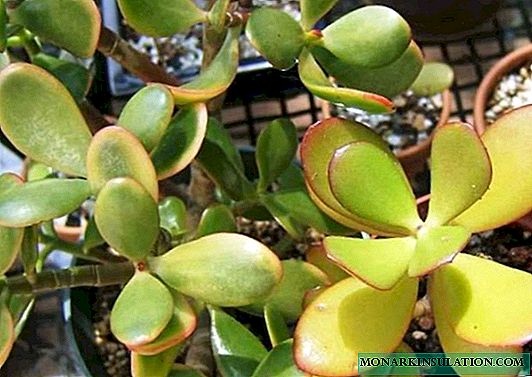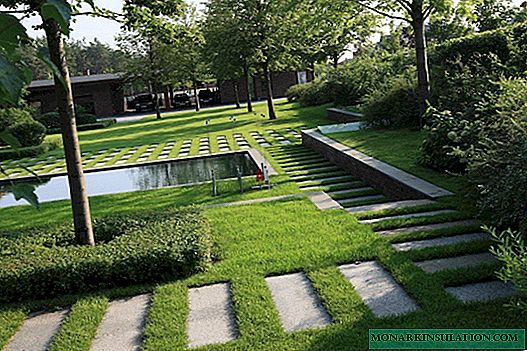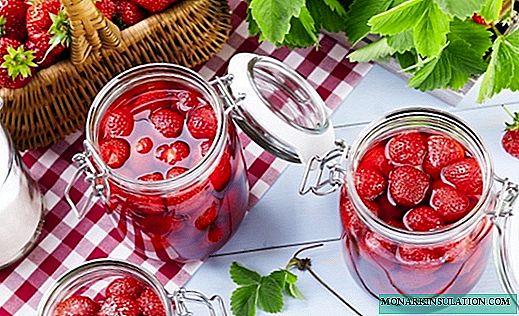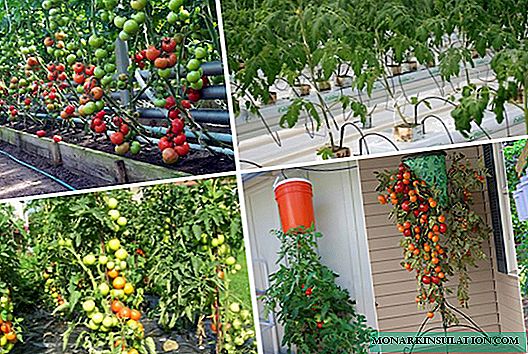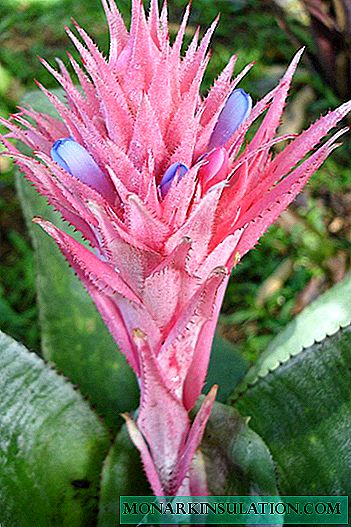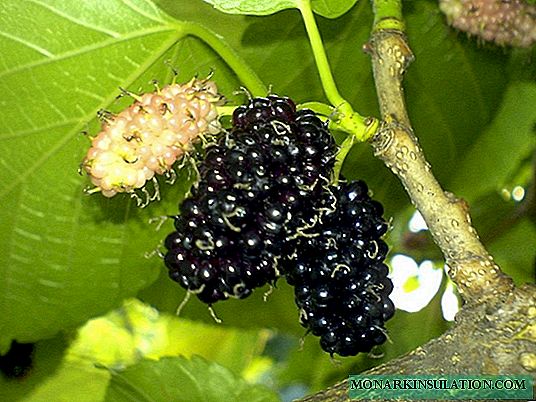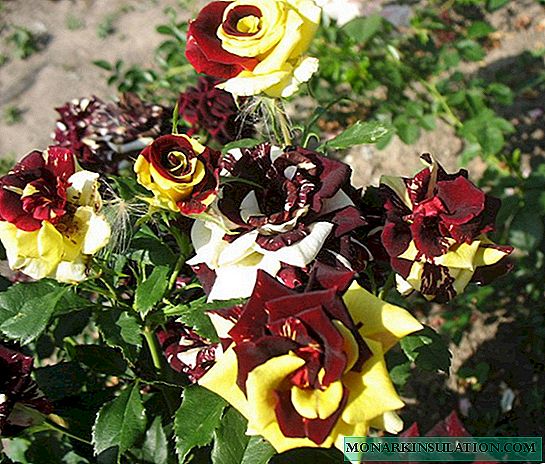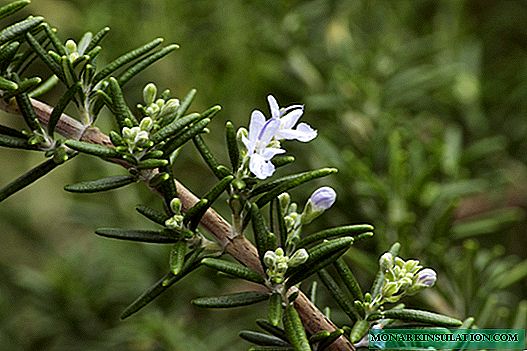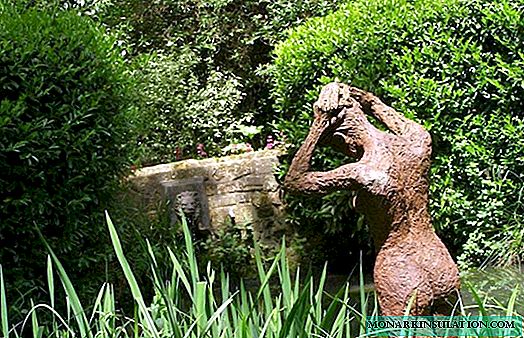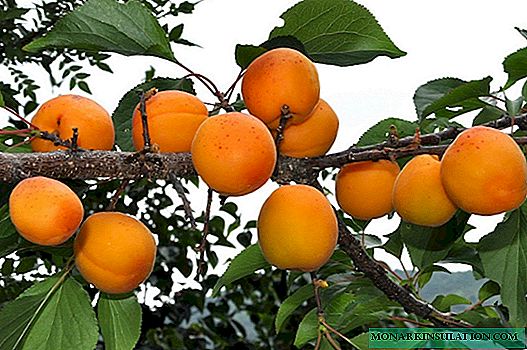
Apricot Khabarovsky has been successfully grown in the Far Eastern region for more than half a century. High winter hardiness and excellent qualities of berries allowed him to hold the championship for decades. It will be useful for gardeners from other regions to get acquainted with this strong and hardy handsome.
Grade description
A tested variety isolated in the Far Eastern Scientific Research Institute of Agriculture by Grigory Tikhonovich Kazmin back in 1949. It was transferred to state variety testing in 1971 and in 1978 it was included in the State Register. It is zoned in the Far Eastern region, grows better in the southern regions of the Primorsky and Khabarovsk territories, and is also available for cultivation in Central Russia.
The tree is strong, tall. By the age of ten it reaches five meters in height and the same in crown diameter. Skeletal branches and annual shoots are thick, straight. The crown is round, spreading, sparse. Fruiting is on two three-year-old wood. Large fruit buds are formed on long and short fruit twigs, growing perpendicular to the main. The flowers are white, large.
The variety has high winter hardiness and frost resistance, provided that it grows in elevated places. In the lowlands, winter hardiness decreases sharply. Flower buds tolerate winter well and freeze extremely rarely. Some gardeners say that Khabarovsky is not hardy enough and can freeze out. But there is reason to believe that these gardeners either chose the wrong place for planting, or neglected certain rules of planting and care.
When planting and growing apricot in extreme conditions for it - every detail is important. Violation of the rules of landing and care leads to disappointment. Alas…
Partially self-fertile, in the Far East, for additional pollination, varieties Snezhinsky and Amur are used. Beginning of fruiting is 4-5 years. Productivity is quite high - up to 40 kg per tree in a successful year.

The young apricot tree Khabarovsk begins to bear fruit for 4-5 years
The fruits ripen very early - in the twenties of July. Due to this feature, some nurseries call this variety - Khabarovsky early. This marketing move with breeding has nothing to do, it only misleads gardeners.
The berries of the variety are round-conical, medium in size. With good yields, the fruit weighs an average of 30 g. If the yield is lower or normalized, then the berries can grow up to 45 g. The color is pale greenish, sometimes it has a dotted orange-red blush. The pubescence is dense, the surface is hilly. The bone is very small, it separates well. The core is sweet.

Khabarovsk apricot berry has a pale green dotted, orange-red blush
The taste of berries is pleasant, sweet-sour. Tasting score 4 points. Transportability and storage capacity are average. Fruits are more often used for fresh consumption.
The variety is well propagated by seeds, without losing its characteristics. However, it is better to propagate it by grafting on frost-resistant stocks. To klyasterosporioz and moniliosis immunity is average, sometimes affected by the moth.
Rules and step-by-step landing instructions
Khabarovsky varieties of apricot are grown, as a rule, in regions with harsh climates and unstable weather conditions. He does not tolerate dampness and stagnant water in the soil. If the snow melts in the tree trunk during the winter thaw, then it will surely freeze and form an ice crust. This crust will injure the trunk bark, and in the case of repeated repetition of this phenomenon (which usually happens at the end of winter), the tree may die. From this it follows that the landing site must be chosen elevated, without accumulation of water and with a deep occurrence of soil water. Apricot grows well on slopes, especially south and southwest, because excess moisture there never stagnates, it just flows down.
Any apricot does not like the cold northern winds - you have to look for a place protected by natural barriers for it. Such protection can be walls of buildings, a fence or tall, thick trees located to the north or northeast of the landing site. But one should not make mistakes at the same time - place the tree in the shade. In this case, the gardener will not wait for the harvest, since the apricot does not bloom in the shade. In the absence of natural protection, artificial should be equipped. To do this, knock down wooden shields and paint them white, for which you can use a mortar. White color reflects the sun's rays, creating additional illumination and warming the crown of the tree.

Apricots grow well on the hillsides
Apricot planting step by step instructions
When planting an apricot tree, the following actions are performed sequentially:
- In the fall, seedlings are purchased. One or two year old plants with well-developed roots and healthy wood are chosen.
- They are laid for storage in the basement or dug into the ground. Before this, the roots are dipped in a mash of mullein and clay, then wrapped with wet burlap or moss.
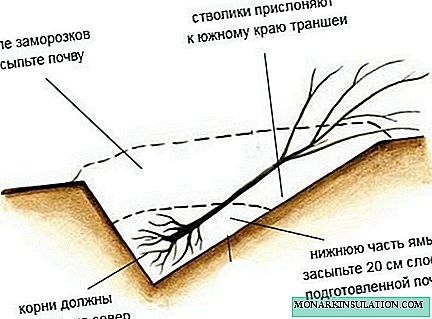
Until spring, the seedling can be kept dug.
- In the fall, prepare the landing pit in the following order:
- Dig a hole measuring 90x90 cm and a depth of 60-80 cm.
- Drain from crushed stone, broken brick, expanded clay, etc., is laid at the bottom.
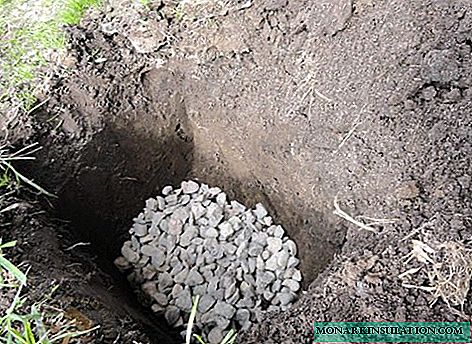
At the bottom of the landing pit, drainage of crushed stone, broken brick, expanded clay is laid
- Then the pit is filled with a nutrient mixture consisting of
- chernozem;
- humus;
- peat;
- sand - these components are taken in equal parts;
- superphosphate 300-400 g;
- wood ash 2-3 liters.
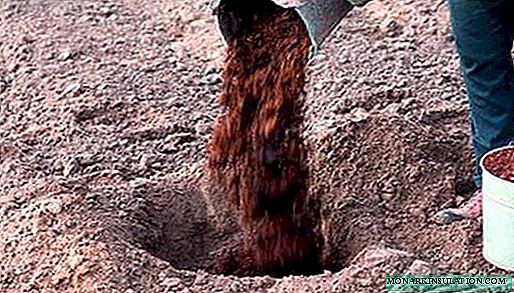
Planting pit filled with nutrient mixture
- At a distance of 15-20 cm from the center of the pit, a wooden stake is driven in. Its height above the ground should be at least one and a half meters.
- Shelter until the spring with waterproof material.
- They begin planting in early spring before the sap flow begins. To avoid stagnation of water and freezing, a mound with a diameter of 2 meters and a height of at least 70 cm is first prepared. It is placed directly above a seasoned landing pit. For its manufacture, the same nutrient mixture is used, which was laid in the landing pit.
- In the center of the hill, next to the stake, they dig a hole sufficient to accommodate the roots of the tree and already form a small mound in it.
- The root neck of a seedling is placed on top of the knoll, the roots are straightened down.
- Now, carefully, layer by layer, fill up the hole, tamping well.
- The seedling is tied to the stake with elastic material. The trunk can not be squeezed.
- A roller is formed on the hill by its diameter, which will keep the irrigation water from flowing out.
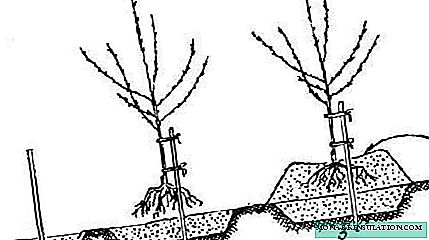
Planting an apricot on a hill will protect the plant from stagnating water and root rot
- Abundantly water the tree. All loose soil must be saturated so that the sinuses formed during backfill disappear.
- The trunk circle is mulched with freshly cut grass, humus, rotted sawdust, etc.
- Cut the seedling by 60-80 cm, if there are branches, shorten by a third.
Features and subtleties of cultivation and care
A variety in the process of growing requires compliance with the usual rules and techniques of agricultural technology, but some of them have features associated with the cultivation region of the variety. We remind the reader briefly about these rules, dwelling in detail on important points for this variety.
Trimming
It is believed that apricots can grow on their own and pruning, if carried out, then sanitary, cutting dry and diseased branches. This is fundamentally wrong. Any fruit tree (and apricot is no exception), in order to increase productivity requires various types of pruning. Khabarovsky does not require any special approach in this regard. Therefore, briefly:
- The formation of the crown should be carried out in the first 4-5 years of life of the tree.
- Due to its rather high growth, it is better to use a sparse-tier crown shape.
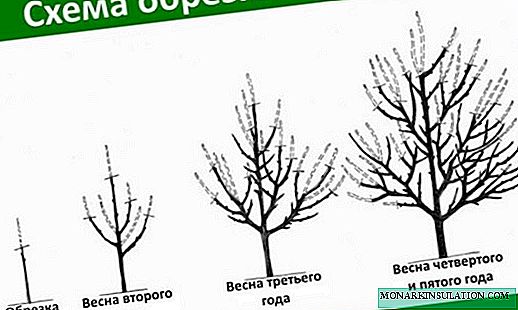
Apricot Khabarovsk form a sparse-tier crown
- Sanitary pruning is carried out annually in late autumn.
- Since Khabarovsky’s crown is rare, regulatory trimming is unlikely to be required.
- No one exempted from the summer coinage of annual shoots. This will increase productivity.
- Well, in the mature age of the apricot, the gardener may think about anti-aging pruning.
Watering
An important agricultural technique. The degree of growth of young shoots and fruits depends on it, especially in the first half of the growing season. We must not forget:
- Apricot is a drought tolerant plant. But, if there is not enough moisture in the soil, he will throw all his strength into preserving the tree. The growth of young shoots and fruits will slow down, the yield will decrease.
- Apricot is rarely watered, but abundantly, moistening the soil to a depth of 30-40 cm.
- After watering, the near-stem circle is loosened and mulched.
- After the autumn water-loading irrigation, the shaft of the near-stem circle is removed, the mound is conical. This technique will not allow moisture to stagnate in the winter, after possible thaws, meltwater will run down.
- Watering is especially important for young (3-5 years old) trees whose root system has not yet reached aquifers.
Top dressing
Needed to maintain high tree productivity. Begin them the next year, after picking up the first crop. It is important to ensure that they are balanced.
Excess fertilizers, especially nitrogen fertilizers, will do more harm to the apricot than their shortage.
Table: Sample Apricot Fertilizer Schedule
| Type of fertilizer | Application Dates and Intervals | Method of application and dosage |
| Organics | Every 3-4 years, in autumn or spring | For digging, 5 kg per 1m2 |
| Nitrogen | Annually in spring | For digging, 30-40 g / m2 |
| Potash | Annually in early summer | Dissolving in water during irrigation, 10-20 g / m2 |
| Phosphoric | Annually in autumn | For digging, 20-30 g / m2 |
| Integrated | Follow directions for use. | |
| Liquid infusions | To maintain the plant in case of a large number of ovaries. During the period of growth of fruits and shoots, they are added 2-3 times with an interval of 2 weeks. | Pre-infusion of one of the components is prepared:
Pour a bucket of water and insist 5-7 days in a warm place. |
Video: how to feed apricot
Diseases and pests how to fight
Most apricots are not very susceptible to diseases and pests. Under favorable weather conditions - sunny summers and the absence of prolonged rains - apricots rarely get sick. The rainy season contributes to the development of fungal diseases. The most important factor in confronting troubles of this kind is the regular conduct of simple preventive measures.
Table: Sanitary and preventive measures to counter diseases and pests
| What do | When do | How do |
| Collection and disposal of fallen leaves | Fall | - |
| Sanitary pruning | Late fall | Dry, diseased and damaged branches are cut |
| Digging trunk trunks | Fall | Produced with the turning of the earth, the roll of the near-trunk circle is removed. |
| Cleaning bark | Fall | They clean the deep roughness with a metal brush. If cracks are detected, they are cut up to live bark and wood, treated with a 1% solution of copper sulfate and covered with garden varnish. |
| Whitewashing of boles and branches | Fall | For whitewashing, a solution of slaked lime is used, to which 1% copper sulfate is added |
| Prophylactic treatment of the crown with 3% solution of copper sulfate | Autumn and spring | Can be replaced with a 5% solution of Bordeaux fluid or 5% solution of iron sulfate |
| Installation of hunting belts | In early spring | Hunting belts set at a height of 30-50 cm from the ground |
| Treatment with complex potent drugs | In early spring | Apply drugs that affect all pathogens of diseases and insects:
|
| Regular treatments with systemic fungicides | After flowering and before harvest | Treatments are especially relevant in rainy summers. They need to be carried out immediately after rains, when the leaves dry out. If the preparation does not have an adhesive, it should be added. Its quality may be a solution of laundry soap or detergent for dishes. Immediately before the harvest, preparations with a short waiting period are used. For example, Horus (used 7 days before eating berries), Quadris (used 5 days before eating berries). |
The main diseases to which apricot Khabarovsky is subject
With strict implementation of recommendations for prevention, diseases in the vast majority of cases can be avoided. But still you need to know how the signs of the manifestation of the main possible diseases look.
Kleasterosporiosis
Hole spotting is the second name for this dangerous disease often found on apricots. Infection with fungal spores usually first occurs in spring. It is brought both by wind, and by means of insects. In the future, spores of the fungus can winter in the bark, fallen leaves and topsoils.
First of all, it affects the leaves on which dark red or burgundy dots appear. Then the points grow, reach significant sizes (up to 5-10 mm), the inner part of the spots dries and falls out, forming holes. Then the leaves turn yellow and fall off. If the plants are not treated with fungicides in time, in August the gardener will be able to observe a phenomenon that is popularly called "summer leaf fall". A weakened tree may not withstand the coming winter and die.

With clasterosporiosis, holes form on the leaves
In addition to leaves, the fungus affects fruits and shoots. On the affected fruits, similar points appear, growing to spots. Further, a continuous coating of berries is possible.
Treatment consists of regular fungicide treatments. The sooner you resort to treatments, the better the result.
Moniliosis
It has a second name - monilial burn. The first infection usually occurs in the spring during flowering. Spores of the fungus on their paws bring bees along with pollen. The process is pretty fast. The fungus begins with a flower, through the peduncle penetrates into the shoot, leaves. The affected parts of the plant wilt, then blacken, giving the impression of a burn.
Inexperienced gardeners can confuse infection with moniliosis with early frostbite of the tree or with an overdose of chemicals during preventive treatment.
Having diagnosed moniliosis, infected shoots with a part of healthy wood are immediately cut out and treated with fungicides. Apply them according to the attached instructions. In the summer, the fungus affects the fruits in the form of gray rot.

In summer, the fungus affects the fruits in the form of gray rot
The causative agent can, like other fungi, winter in the bark of a tree, leaves and soil.
Cytosporosis
Fungal infection of the bark of a tree. It contributes to the presence of untreated cracks, which spores of the pathogen fall into. Developing, the fungus eats away the bark, it loosens, becomes rotten. From the crack occurs abundant gumming. Treatment, as well as prevention, consists in cleaning the damaged areas to a healthy bark and wood, disinfection with 1% solution of copper sulfate, treatment with fungicides and protecting the wounds with garden var.

Cytosporosis can completely destroy apricot bark and wood
It is interesting. The first chemical tool to combat fungal diseases of fruit plants was invented by the French botanist Alexander Millard in 1885. This is the so-called Bordeaux fluid, which to this day is often used by agronomists and gardeners around the world.
Pests
They attack apricot less often than diseases, but no less can cause harm.
Weevil beetle
This small bug with a long proboscis hibernates in soil, fallen leaves and bark.In early spring, it rises along the trunk to the crown and begins to satisfy hunger. At this stage, it should be stopped by a calcareous whitewash and a hunting belt. Weevil eats everything that comes across. It starts with buds and buds, then moves on to leaves, ovaries, young shoots. Insecticides help - in early spring DNOC, Nitrafen, then Decis, Fufanon. It is still cold and the air temperature in the mornings does not exceed + 5 ° C, the beetles sit numb on branches. At this time, they can be shaken off on a pre-lined fabric or film.

Weevil eats, eats buds, buds, leaves
Khrushchev
In May, the weevil, as well as other beetles (May, April, etc.) begin to lay eggs in the soil. By the beginning of summer, larvae creep out of the eggs, which they call Khrushch. In the weevil they are small - 4-6 mm, in the May beetle more impressive - 20-25 mm, the largest larvae in the April beetle - 30-35 mm. One thing unites them - over the next few weeks they will feed on the roots of plants, including apricot. Then, at a depth of 30-50 cm, the larvae pupate. The pupation period lasts 2-4 weeks. Then, in late summer or early autumn, a beetle emerges from the chrysalis, but remains in the cradle until next spring. Next, the cycle repeats. The gardener will collect part of the pupae during the autumn digging.

Raspberries feed on plant roots
During the active life of the crustaceans, they are destroyed by the drug Diazonin. They cultivate the soil in near-stem circles. The exposure period is three weeks, which is enough to cause significant damage to the population. Diazonin does not accumulate in soil and fruits.
Additionally, you can arrange traps. A mound of moist humus or compost is poured near the plants and covered with a black film to create a greenhouse effect. The larvae will rush into comfortable conditions for them. After a while, after heaping a heap, they are collected and destroyed. The operation can be repeated. At the same time, slugs will crawl into this pile, if they are on the site.
Aphid
Small insect with many varieties. It feeds on juicy leaves and young shoots, while secreting sweet mucus. This mucus tastes ants. In order to enjoy it, the ants on their backs carry aphids on the crown of a tree and plant them on leaves. This will not happen if the trunk is whitewashed and a hunting belt is installed on it. Aphids can be detected by the presence of twisted leaves. By expanding such a leaf, you can see many tiny insects. They can have different colors - black, green, yellow, white, etc. Treatment with insecticides will give a limited effect, since the drug will not be able to penetrate the folded sheet. To enhance the effect, you must first tear off the twisted leaves as much as possible.

The aphid is located on the inside of the leaf
Grade Reviews
I have 2 apricots Khabarovsky. One tree is more than 26 years old, the second is 4 years old. An adult tree has yielded a large crop. Even too much. This usually weakens the tree. Let's see what will happen in spring. We put an apricot on excess crops. I never did it. I will see what happens.
Anna, Khabarovsk (cottage with. Malyshevo)//plodpitomnik.ru/forum/viewtopic.php?t=425
Today in the crown of the Academician I saw a branch with the fruits of Khabarovsky. The fruits are ripe. The tree is on the highest and sunniest place. On another tree, lower on the slope, the fruits are far from ripe. In the sun, the fruits gained a beautiful glow. Very tasty
Vladimir-27, Khabarovsk, (Khekhtsir)//plodpitomnik.ru/forum/viewtopic.php?t=425
For me, the Khabarovsk variety is the number one to taste among all. Always always good taste!
Ivan Sergeevich, Ussuriysk//plodpitomnik.ru/forum/viewtopic.php?t=425
Regarding the winter hardiness of this variety. In general, apart from Ranniy Marusich, nothing openly grew from varietal apricots, but the Khabarovsky apricot variety in my area did not even try to winter. That is, if other apricot varieties came out frozen after wintering and then during the summer some branches were restored, and some branches disappeared, then Khabarovsky completely froze.
Vladimir-27, Khabarovsk (Khekhtsir)//plodpitomnik.ru/forum/viewtopic.php?t=425
Apricot Khabarovsky has undeniable advantages - winter hardiness, fruit quality, productivity. Minor flaws do not prevent him from successfully occupying a large niche in his region. Gardeners of the Middle Strip should take a closer look at this variety, as it is freely adapted to the conditions of the area.






